 Aircrew Chronicles
Aircrew Chronicles  |
Aircrew Losses
|
Nose Art
|
BCATP
|
Lancaster
|
Media
|
Aircrew Losses
|
Nose Art
|
BCATP
|
Lancaster
|
Media
 Aircrew Chronicles
Aircrew Chronicles  |
Aircrew Losses
|
Nose Art
|
BCATP
|
Lancaster
|
Media
|
Aircrew Losses
|
Nose Art
|
BCATP
|
Lancaster
|
Media
Bomber Command Aircrew Chronicles
|
Charles Prichard Lesesne's ancestors were French Huguenots and the family settled in South Carolina where Charles was born in 1911. After attending the University of South Carolina, he worked as an aviation writer before World War II, he was reporting on the exciting and new aviation technology and had a syndicated newspaper column called "Wing-Overs." Just before becoming an flying instructor in the RCAF, he was part of the editorial staff of the Charlotte Observer in North Carolina from 1935 until 1939 and the Sumter Daily Item during 1940 and 1941. Although his motivation is not known, Chuck Lesesne joined the Royal Canadian Air Force in February, 1941 and received his wings at No. 16 SFTS at Hagersville, Ontario. He then served as a flight instructor at No. 2 Bombing and Gunnery School at Mossbank, Saskatchewan for two years. During that time he was involved in an accident that was reported in the Charlotte Observer as follows: "Flying Officer Charles Lesesne or the Royal Canadian Air Force, formerly a member of the editorial staff of the Charlotte Observer, was dangerously injured yesterday in a motor accident near Mossbank, Saskatchewan, his mother, Mrs. Elizabeth Lesesne of Sumter, S.C., was informed in a telegram late yesterday. No details of the accident were given in the telegram, which added that his condition was good and that a letter would follow. It was supposed he was injured in an automobile accident near his station."
|
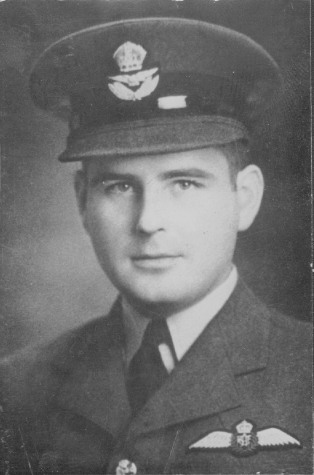
|
Throughout his career with the RCAF, Lesesne would have been viewed as an "old man," after joining at the age of thirty. It seems quite likely that he did all he could to arrange for an overseas posting and the assignment to wartime operations. He was assigned to No. 431 "Allouette" Squadron. This was the RCAF's largely French speaking squadron and it is likely that Lesesne had learned the language through his Huguenot background.
Halifax NR-271 was marked "KW-N" and based at Tholthorpe in Yorkshire. Following her first two operations, "KW-N" was assigned to F/O Chuck Lesesne. The crew chose the name "Nuts for Nazis" with artwork that featured a monkey wearing flying gear and spitting out engineering nuts, one for each operation flown. Halifax "KW-N" flew a total of 43 operations, 19 of them by F/O Lesesne.
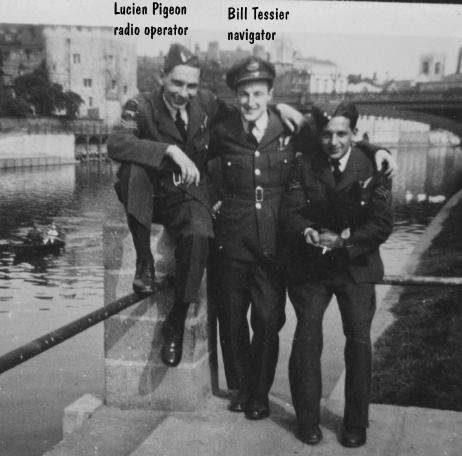 Bill Tessier (navigator), Alphonse Laliberte (bomb aimer) |
Lucien Pigeon was aboard Lesesne's Halifax Bomber (KW-C; MZ-418) when it was shot down on 31 March, 1945. The following information regarding Lesesne's last flight on March 31, 1945 was provided by Louise, Danielle, and Richard Pigeon, three of Lucien's Pigeon's children in early September 2007. "Joseph Hermas Lucien Pigeon was born on the 4th of August 1914. He joined the RCAF on April 24th, 1942. After air gunner training in Mossbank, Saskatchewan (where he likely came to know Chuck Lesesne) and wireless training in Guelph Ontario, he was assigned to No. 425 Alouette squadron in Tholthorpe as a wireless operator. He received an officer's commission and promotion to the rank of Pilot Officer on 19 December, 1944. On March 31st 1945, the day before Easter, he was the wireless operator aboard a Halifax bomber (piloted by Charles Lesesne) that was shot down while on a daylight bombing mission to Hamburg. |
After the war, like so many veterans, Lucien would not speak about his wartime experiences. However his children noticed that every Easter, he would become emotional as memories of the events of Easter 1945 returned. It was on one of those occasions that he told his son about the events surrounding the death of Charles Lesesne.
On Good Friday, March 30th, the crew had been given leave until the next morning.
Two of Lucien's crewmates and good friends, Bill Tessier the navigator and Alphonse Laliberte decided to go into town. They invited Lucien to join them but he declined, intending to pick up a new uniform and also attend Good Friday services.
At around 11 p.m., orders were received for an early morning mission planned for the next day. Three crewmembers, including Tessier and Laliberte, were still absent. Lucien said that this was a common occurrence and vehicles with loudspeakers would go through the nearby towns informing the crews that they had to return to base. The missing crewmen did not return in time and they were replaced by substitutes.
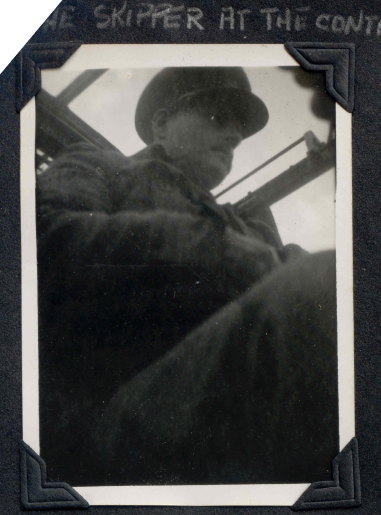
|
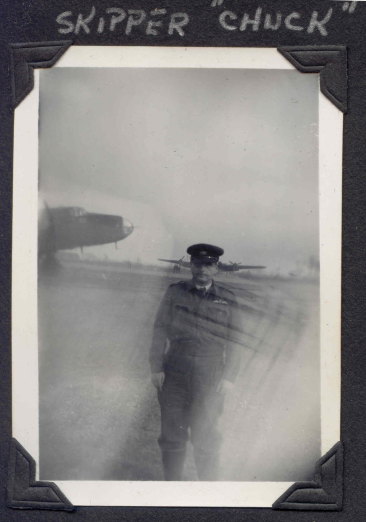
|
The flight to Hamburg did not proceed as planned as the substitute navigator appeared to be lost when they neared Hamburg (there was a solid overcast).They were outside the bomber stream and flying alone when the Halifax sustained fatal damage. Lucien was of the opinion that the aircraft was hit by anti-aircraft fire. At the time, he was busy at his cramped radio operator position and he did not hear the call to abandon the aircraft. As a result, he was the last one to snap on his parachute and exit the aircraft.
He landed in the Bergen-Belsen concentration camp, was apprehended and taken immediately to a local police station where other crewmembers had also been taken, including the severely injured pilot Charles Lesesne. The crewmembers pleaded with the authorities to call a doctor for Lesesne but they were ignored. Charles Lesesne died in the police station in the arms of Lucien Pigeon.
Pigeon was taken to Stalag Luft 1, Barth Germany. While a prisoner there, he met Roger Savard, whose Beaufighter had been shot down in Norway and where he had been severely interrogated by the Germans. Roger, who later became promotions director for the Montreal Expos, and Lucien, remained lifelong friends. This camp was liberated by Soviet troops one month later, in May 1945. Lucien Pigeon was 86 years old when he died on July 13th 2001."
Kenneth K. Blyth was a pilot with No. 408 squadron based at Linton-on-Ouse. His Halifax was shot down near Hamburg by three Me-262 jet fighters on the same day as the Lesesne aircraft was lost. Blyth became a prisoner of war at Stalag Luft 1, Barth, Germany.
In his book, "Cradle Crew," he wrote that he was assigned the same barrack #13 and the same room, #11, as Lucien Pigeon and William Cable, from Winnipeg, the substitute bomb aimer on Charles Lesesne's Halifax. Roger Savard, the 404 squadron Beaufighter pilot shot down in Norway on February 9th 1945, on the day known as "Black Friday", was also in the same room. He was the only survivor of the six Canadian Beaufighters shot down that day.
On page 81, Blyth writes: "Bill Cable, from Winnipeg, Manitoba, had to be excited that they were able to have their "Number 30" (the last operation in his tour) for their pilot as a daylight raid, the target being the prefabricated submarine base at Hamburg, Germany. This was the same raid on which we "bought" it. Cable was the bomb aimer on Halifax. The kite was hit in the bomb bay by flak, but the bombs did not explode. Almost simultaneously the aircraft was attacked by three ME-262s. (I wonder if it was the same threesome that came after us.) All the crew bailed out, but the pilot (Lesesne) died later from the wounds he received before leaving the aircraft. I often wondered when Bill returned to England whether the squadron gave him credit for a full tour."
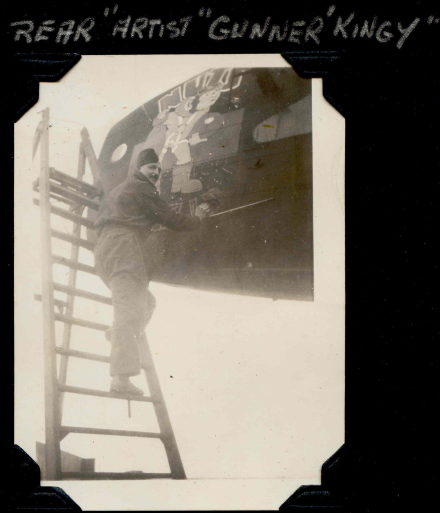
|
In a letter published in Airforce Magazine (Winter 2008), Francois Guy Savard (F/L Retired) described his recollections of what Lesesne's crew told him regarding what happened to their pilot. He wrote that, "I sat across the table from him (Lesesne) in the Mess for the pre-op meal before the Hamburg operation. Lesesne was in a very jovial mood, laughing and cracking jokes as if he did not have a care in the world . . . Upon landing he felt really exhausted and decided to lie down and rest a bit. Unbeknownst to him, he had come down near a flak battery operated by women. They saw him lying there and proceeded to beat him quite severely. Sometime later, Lesesne's battered body was thrown in the same cell as some of his crewmates. He was clearly near death so they called the guards and demanded medical help for their skipper. The reply they received was that every doctor in Hamburg had his hands full that night. Lesesne told the story to his crewmates before he died. He was the last member of No. 425 Squadron to die on operations in World War II. "We will never know how many members of bomber crews suffered the same fate as Lesesne but that possibility was always at the back of our minds. We were briefed not to resist capture; we were not armed. If you were shot down and could not evade capture, 'for you the war was over.'" |
Chuck Lesesne's mother, Elizabeth "Bessie" Lesesne, relayed the following to her grandson, Henry Hilton Lesesne, Jr., about Charles. "When Charles was killed in action during World War II, she claims to have awakened about 2 AM to see his ghost standing at the foot of her bed. Charles' ghost said something to the effect of "Mama, I died over there. I love you." He then disappeared. Henry Jr. believes her story because of the earnest tone of her voice and seriousness of her demeanor."
"F/Lt. Lesesne's surviving aircrew were Canadians, F/S Robert Villiard, 22, navigator; P/O Lucien Pigeon, 29, from Montreal, Radio Operator; F/O William B. Cable, 21, from Winnipeg, Bombardier; F/S Frederick Henry King, 35, Rear Gunner; W/O Raymond Trudeau, 23, Rear Gunner; Sgt John Tame, 20, Flight Engineer, son of M.G. Tame, 49 Blackmore Grove, Teddington, Middlesex, England;"
No. 425 Squadron RCAF Halifax NR-271 was marked "KW-N" and based at Tholthorpe in Yorkshire. Following her first two operations, "KW-N" was assigned to F/O Chuck Lesesne. The crew chose the name "Nuts for Nazis" with artwork that featured a monkey wearing flying gear and spitting out engineering nuts, one for each operation flown. Halifax "KW-N" flew a total of 43 operations, 19 of them by F/O Lesesne. KW-N (Nuts for Nazis) ==> |
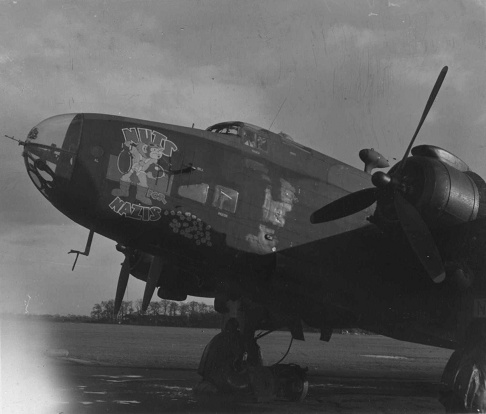
|